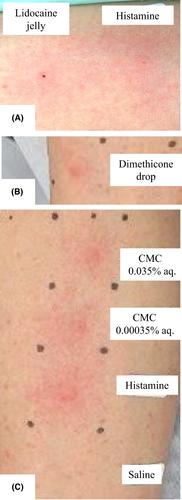对利多卡因果冻和二甲基硅氧烷滴剂中羧甲基纤维素的立即过敏反应:一个病例报告和小型回顾
IF 0.9
Q4 ALLERGY
引用次数: 1
摘要
辅料过敏是罕见且难以诊断的。羧甲基纤维素(CMC, carmellose钠)是从天然纤维素中提取的阴离子水溶性聚合物,即用作赋形剂。在此,我们报告一例因利多卡因果冻和二甲硅氧烷滴剂中CMC引起的荨麻疹,该滴剂曾用于上消化道内窥镜检查。CMC广泛应用于医药制剂、食品添加剂和其他药品中,其用途日益扩大。然而,由于含有CMC的物质而引起立即过敏反应的报道很少。以前的报告和我们的病例表明,辅料,如CMC,可能是潜在的隐藏过敏原。本文章由计算机程序翻译,如有差异,请以英文原文为准。

Immediate hypersensitivity reaction to carboxymethylcellulose in lidocaine jelly and dimethicone drops: A case report and mini-review
Excipient allergies are rare and difficult to diagnose. Carboxymethylcellulose (CMC, carmellose sodium) is an anionic water-soluble polymer derived from native cellulose, that is, used as an excipient. Here, we report a case of urticaria caused by the CMC in lidocaine jelly and dimethicone drops, which had used for upper gastrointestinal endoscopy. CMC is widely used in pharmaceutical preparations, food additives, and other pharmaceuticals, and its use is increasing. However, there are few reports on immediate hypersensitivity reactions because substances containing CMC. Previous reports and our case suggest that excipients, such as CMC, can be potential hidden allergens.
求助全文
通过发布文献求助,成功后即可免费获取论文全文。
去求助
来源期刊

Journal of Cutaneous Immunology and Allergy
Medicine-Dermatology
CiteScore
0.60
自引率
10.00%
发文量
69
审稿时长
12 weeks
 求助内容:
求助内容: 应助结果提醒方式:
应助结果提醒方式:


